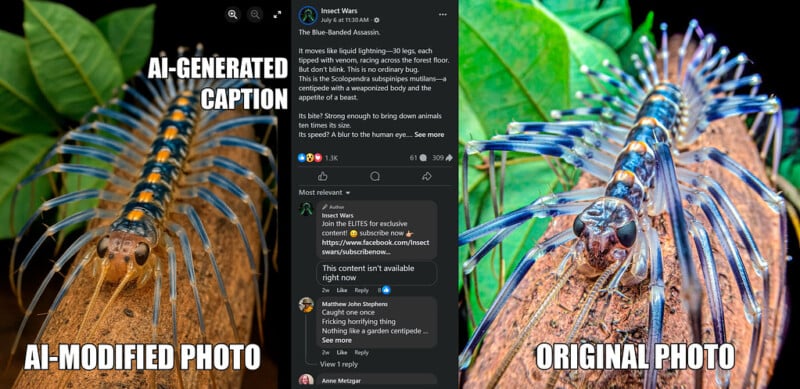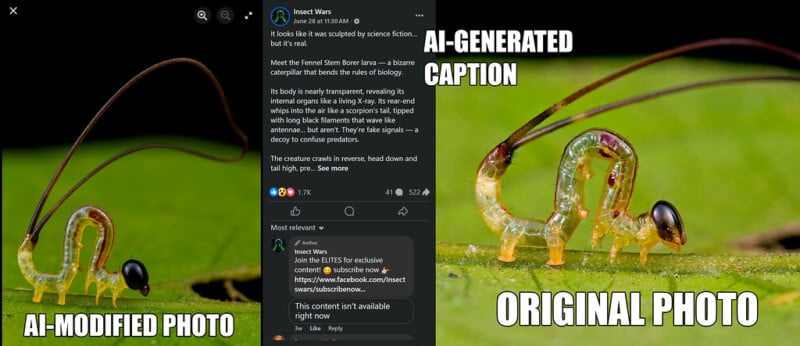AI is Ruining Nature Photography on Facebook

Nature photographers have raised the alarm that AI slop pages on Facebook are stealing their work, editing their pictures with AI, and then reuploading them without credit while passing them off as real creatures.
Macro photographer Nicky Bay tells PetaPixel that a number of high-profile nature photographers have complained that their work is being stolen and “mangled into AI-nonsense,” deceiving viewers by accompanying the pictures with made-up stories in the caption.
Bay says that these pages, some of which have millions of followers, are cherry-picking photographers’ images and using AI to regenerate the photos for social media, thereby avoiding copyright infringement scanners.
“It is not just unethical and unlawful. The ones who do it don’t even care what the content is about,” Bay writes on his website. “The generated photo sometimes showcases anatomically incorrect details. The accompanying text is also generated by AI and is almost always factually wrong.”
Bay shared examples of the offending posts with PetaPixel where his work has been stolen.








Photographer Nick Volpe has also addressed the issue, calling it an “AI takeover.” Volpe says that “over 90%” of what is showing up on newsfeeds is fake.
“The AI images are now getting so good that they are fooling even renowned naturalists. Many of these pages are now using AI to create images of real animals, so the images are looking close, if not exact replicas of this species,” writes Volpe.
Volpe says that these immoral Facebook pages are being paid by Meta for posting this content and accuses the platform of pushing the fake content into newsfeeds. “The people behind these pages are making money literally stealing content from dedicated wildlife photographers,” he adds.
Meanwhile, Volpe says that his own reach has become limited and that it is “harder to continue sharing work on this platform.” He suggests people should only follow photography pages where there is a face to the artist.

PetaPixel reached out to one of the pages, Insect Wars, which has 1.7 million followers on Facebook and 1.2 million on Instagram, but did not hear back as of publication. Insect Wars publishes demonstrably false content that is passed off as real, often using photographers’ work as the basis.


Photographer Gil Wizen has also talked about this issue, revealing in May that he discovered several accounts have been using his photos as the basis for AI-enhanced photos.
“The AI images dilute the exclusivity of the original photos, making it harder to offer them to paying clients, and damage the photographer’s income,” Wizen says of the impact these images have.
“It also misleads viewers to believe these AI creations are real. Those of us with a strong connection to nature can easily detect that something is off here, but the general public cannot, and it breaks my heart to see people enjoying and celebrating something that is fake. To put it quite simply, it’s a lie, a deception.”

Wizen and Bay have both managed to successfully remove some of the offending AI pictures via DMCA takedowns. However, these requests take one to two weeks which is far longer than the usual time of just one day when reporting a standard stolen photo to Facebook.
Meta has been approached for comment.
Update 8/7: Updated with DMCA takedown information.